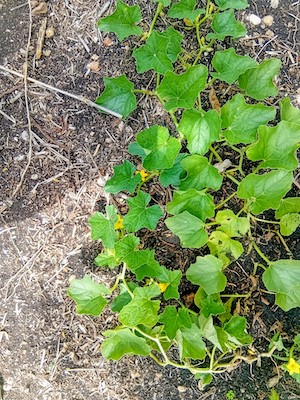Tropical Garden Grow Guide
Where you are the student and the teacher


Cantaloupe Vine
| Botanic name: | Cucumis melo | |
| Plant Type |
melon |
|
| Sun Exposure |
full sun, 6-8 hrs per day |
|
| Soil Preference |
welled drained | |
| Soil pH |
6-8 |
|
| Depth to plant |
1 inch |
|
| Maturity |
81-90 days |
|
| Height |
12-18 " |
|
| Spread |
3-6 feet |
|
| Spacing |
space seeds 3 ft apart. |
Cantaloupe
by Mary Loan
Cantaloupe
(Cucumis melo) is
a popular melon grown commercially or in the home
garden in Belize.
Cantaloupes are a member of the muskmelon
family. The
fruits are considered to be
pepos, part of the berry family with a hard rind and
seeds contained
within. The
melons are heat loving with
a long growing season (81-90 days).
Cantaloupes
have been
cultivated for over 4,500 years. They
are believed to have originated in Persia, then
cultivated in Egypt and Iran to
India, then to parts of the world with warm
climates. The
melons require full sun and regular water
for optimum growth to harvest.
A simple way to
grow your own without having
to purchase seeds is to buy a local cantaloupe, eat
and enjoy the sweet orange
flesh, then save the seeds. The seeds
can be rinsed well in a fine sieve then allowed to
dry for easier
handling. The
seeds can be started in
growing containers and transplanted when the sprouts
are about 3-4 inches in
length or directly planted in your garden.
Cantaloupes are tolerant of most soils as
long as it is not hard
clay-like soil.
The pH range is from
5-7, with 6.8 considered to be ideal.
To
plant from seed in your
garden, water the soil first and allow it to dry a
bit until just moist, but not soggy. Work in about ½
cup of vermiculture per hill.
Plant 2-3 seeds about ½ inch deep in hills
located at least four feet
apart to allow the vines to sprawl. To
plant from seedlings, it is best to plant in the
late afternoon to allow the
seedlings to adjust to the garden before the hot
sun. On
very hot and dry days, some shade will
benefit the plant's transplantation. I put our
lawn chairs on top of the hills to provide shade.
When the vines flower in
approximately 35-45 days it is pollination time;
work that is generally done by
bees, it can also be done by you in your garden with
a Q-tip
or a very narrow paintbrush.
Plants
generally ripen to
harvest in about 81-90 days. The fruits
should by raised from the earth by using straw
mulch, boards or tin cans etc. to prevent
ground bugs from eating them before you do.
Some growers use trellis gardening as the
vines are strong enough to
support the cantaloupes.
Unfortunately
cantaloupes are
prey to many kinds of insects and plant diseases. Home
gardeners can pick off
some to the bugs.
A general all purpose insect and disease
prevention formula is as
follows:
Mix
7 TBS. Epsom salts
and 4 TBS. Borax in 5 gallons of water. It is
advised to spray when the plants begin
to vine and again when the melons are about the
size of a hard ball.
Cantaloupes
are ready for
harvest when the skin turns from green to whitish
yellow. It
is said that with a light tug the fruit
separates from the vine when they are
ripe. Some
sniff the stem for a musty aroma.
Cantaloupes
are nutritionally
dense. They
contain antioxidants,
collagen, Vitamins A and C and potassium.
They can be eaten after being deseeded in
slices, cubes or melon balls. They make
a delicious and colorful addition
to your favorite gazpacho recipe or smoothie.
Why
not try a delicious chilled cantaloupe soup recipe
on a hot sultry day.
The following recipe is a combination from a
mix of all the wonderful recipes that are available
via Google.
Recipes:
Cantaloupe is normally
eaten as a fresh fruit, as a salad, or as a
dessert with ice cream or custard. The seeds are edible
and may be dried for use as a snack.
Cantaloupe can be pureed and used in cold soup,
sorbet, ice cream, or smoothies.
Chilled Cantaloupe Soup
serves about six:
1 cantaloupe peeled, seeded and
chopped
2 cups orange juice
juice of one lime
a good swirl of honey (optional)
a few dashes of cinnamon
a sprinkle of nutmeg (optional)
watermelon balls and a sprig of
mint (optional)
place 1/2 of the chopped
cantaloupe in a blender
add 1 cups orange juice, blend
till smooth
repeat with the rest of the
chopped cantaloupe
and the other cup of orange
juice
dust the soup mixture with the
cinnamon and nutmeg
Serve with a nest of watermelon
balls and a sprig of mint
in the center of each bowl
Chill for at least one hour,
then serve.
Bon appetit!
Ingredients
- 1 ripe cantaloup
- ½ cup white
sugar
- 1/2 cup flour
- 1/4 teaspoon salt
- 3 eggs
- 2 tablespoons water
- 1 tablespoon butter
- 1/4 teaspoon butter
flavored extract
- 1 9"baked pie crust
- 3 large egg whites
- 1/4 teaspoon cream of
tartar
- 6
tablespoons white sugar
Directions
- Preheat oven to 400
degrees F or 200 degrees C
- Cut cantaloupe in half,
remove seeds, and scoop flesh into a medium
saucepan. Cook over medium heat until it comes to
a gentle boil; mash cantaloupe as it heats. This
should make about 2 cups pulp
- Combine 1/2 cup sugar,
flour, and salt in a medium bowl; add to pulp in
the saucepan and cook, stirring, over medium heat
until thick.
- Whisk together egg yolks
and water in a large bowl. Whisk in a little of
the hot pulp to heat yolks gradually, then pour
egg yolk mixture into remaining pulp in the
saucepan. Continue cooking, stirring, until
filling is thick and creamy. Remove from heat.
- Stir in butter and extract
until incorporated. Pour filling into baked pie
crust.
- Beat together egg whites
and cream of tartar with an electric mixer in a
second large bowl until frothy. Continue beating,
adding 6 tablespoons sugar gradually; beat until
thick peaks form. Spread meringue over filling
- Bake in the preheated oven until meringue is delicately brown, 18 to 20 minutes.
